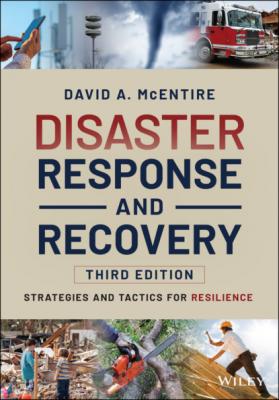Disaster Response and Recovery. David A. McEntire
Чтение книги онлайн.
Читать онлайн книгу Disaster Response and Recovery - David A. McEntire страница 16

1.1.1 Important Concepts
Disasters are defined as deadly, destructive, and disruptive events that occur when a hazard interacts with human vulnerability. Disasters are significant societal events that injure and kill people, damage structures/infrastructure and personal belongings, and complicate the routine activities people undertake on a daily basis (e.g., sleeping, bathing, cooking, traveling, going to school, working, etc.).
Table 1‐1 Comparison of Event Magnitude.
| Accidents | Crises | Emergencies/ disasters | Calamities/catastrophes | |
|---|---|---|---|---|
| Injuries | Few | Many | Scores/hundreds | Thousands/more |
| Deaths | Few | Many | Scores/hundreds | Thousands/more |
| Damage | Minor | Moderate | Major | Severe |
| Disruption | Minor | Moderate | Major | Severe |
| Geographic impact | Immediate area | Local community | Regional | National/international |
| Availability of resources | Abundant | Sufficient | Limited | Scarce |
| Number of responders | Few | Many | Scores/hundreds | Thousands/more |
| Time to recover | Minutes/hours/days | Days/weeks | Months/years | Years/decades |
In the simplest of terms, there are two categories of variables that interact to produce a disaster. A hazard is the risk, trigger or threat that initiates a disaster. Hazards include natural, technological or anthropogenic (human‐induced) agents like earthquakes, industrial explosions, or even terrorist attacks that negatively affect people or critical infrastructure. Vulnerability, on the other hand, refers to the proneness of people to disasters based on factors such as their geographic location, exposure of property, level of preparedness, income and/or other social variables. The ability of individuals, organizations, and communities to deal with disaster also determines the degree of vulnerability. Vulnerability is therefore the human element of disasters, while hazard agents may or may not always have a direct social cause.
Although disasters result from the interaction of both hazards and vulnerability, the two concepts have distinct implications for practical application. Because it is not always possible to prevent or control hazards, people and organizations should give extra attention to efforts that reduce their vulnerability to disasters (McEntire 2005). For this reason, the knowledge and expertise of individuals that are employed in emergency management and related professions are required to deal effectively with mass emergencies, disasters, calamities and catastrophes (Figure 1‐1).
From an academic standpoint, emergency management “is the study of how humans and their institutions deal with hazards, vulnerabilities and the events that result from their interaction” (Jensen, 2013). The emergency management discipline accordingly seeks to create and disseminate knowledge about what people and organizations can do to diminish the frequency and impact of disasters. From a practical perspective, emergency management “is the managerial function charged with creating the framework within which communities reduce vulnerability to hazards and cope with disasters” (Blanchard et al., 2007, p. 4). This suggests the need for highly educated and trained individuals who are given the responsibility to advance the goals of reducing disasters and reacting to them in an effective manner. These professionals are known as emergency managers; they have a keen “interest in disasters and a strong desire to alleviate the suffering of those impacted” by these adverse events (Phillips, Neal and Webb 2017, p. 106).
Figure 1‐1 Emergency management personnel often attend meetings to prepare for future disasters.Michael Rieger/FEMA.
http://www.spc.noaa.gov/faq/tornado/ef‐scale.html
Put differently, emergency managers are public servants that help jurisdictions reduce the liabilities that lead to disasters. These employees (governmental and even non‐governmental) also work closely with many concerned stakeholders and endeavor to build capabilities to deal more effectively with hazards and disasters. Such activities are commonly described as the disaster life cycle or the four phases of emergency management. These proactive and reactive efforts include mitigation, preparedness, response and recovery:
Mitigation refers to several priorities and actions, including risk reduction, loss minimization, and/or the alleviation of potential negative impacts associated with disasters. Careful land‐use planning, improvements in building design and construction, and a reliance on insurance to cover the costs associated with disasters are examples of mitigation activities.
Preparedness implies efforts to increase readiness for a disaster. Examples of preparedness initiatives include the creation of laws/ordinances, the acquisition of grants or other resource s, and various measures such as planning, training, exercises and community education.
These two phases ‐ mitigation and preparedness ‐ should be given the highest priority in the emergency management profession today. For this reason, emergency managers must not be seen solely as an extension of first responders— our wonderful police, fire, and emergency medical personnel who serve so valiantly when emergencies occur. The goals of emergency managers are more proactive and encompassing than emergency response, even if they do overlap with the objectives and operations of these heroic public servants at times.
However, because it is impossible to eliminate all disasters, emergency managers must also be involved in disaster response and recovery operations. Disaster response includes actions “taken immediately before, during, or directly after an emergency occurs, to save lives [and] minimize damage to property” (Godschalk, 1991, p. 136). Examples of disaster response functions include
Warning people of severe weather
Evacuating those who are assumed to be at risk
Sheltering